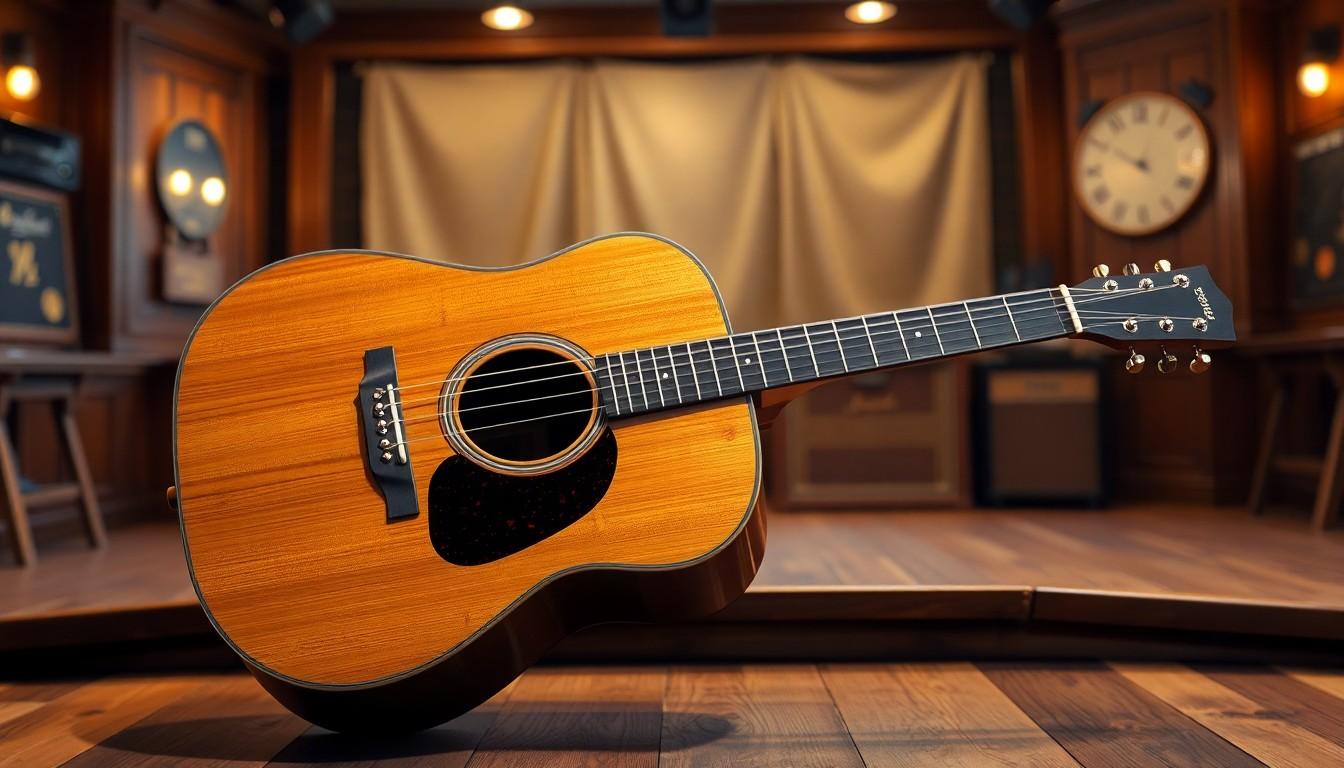Picking the perfect acoustic guitar size can feel like choosing between a cozy studio apartment and a sprawling mansion – it’s all about finding the right fit. From the compact parlor guitar that’ll squeeze into any space to the booming jumbo that demands attention, each size brings its own unique character to the music.
Whether someone’s shopping for their first six-string companion or adding to their growing collection, understanding acoustic guitar sizes isn’t just about comfort – it’s about sound. The body dimensions directly influence the tone, volume and playing experience. A dreadnought might bring that classic country twang while a concert size delivers intimate warmth perfect for fingerpicking. And let’s be honest – nobody wants to wrestle with a guitar that feels like hugging a redwood tree or one that looks like a ukulele’s slightly bigger cousin.
Acoustic Guitar Sizes
Acoustic guitar body sizes range from compact travel models to full-sized dreadnoughts. Each size category produces distinct tonal characteristics based on its physical dimensions.
Common Size Classifications
-
- Parlor: A compact 12-inch-wide body ideal for fingerpicking styles
-
- Concert: A 13.5-inch-wide body offering balanced tone for folk music
-
- Grand Concert: A 14-inch-wide body delivering enhanced projection
-
- Auditorium: A 15-inch-wide body providing versatile sound options
-
- Grand Auditorium: A 16-inch-wide body balancing comfort with volume
-
- Dreadnought: A 15.5-inch-wide body creating powerful bass response
-
- Jumbo: A 17-inch-wide body generating maximum volume output
Size Comparison Chart
| Guitar Size | Body Width | Body Length | Body Depth | Best For |
|---|---|---|---|---|
| Parlor | 12″ | 18″ | 3.5″ | Blues fingerpicking |
| Concert | 13.5″ | 19″ | 4″ | Folk intimate venues |
| Grand Concert | 14″ | 19.5″ | 4″ | Recording sessions |
| Auditorium | 15″ | 19.5″ | 4.125″ | Versatile playing |
| Grand Auditorium | 16″ | 20″ | 4.625″ | Stage performance |
| Dreadnought | 15.5″ | 20″ | 4.75″ | Bluegrass strumming |
| Jumbo | 17″ | 21″ | 5″ | Country flatpicking |
Full-Size Dreadnought Guitars

Dreadnought guitars stand as the most popular acoustic guitar body style. These instruments feature a wide waist width of 11.5 inches a body length of 20 inches creating a large resonating chamber.
History and Origins
The C.F. Martin Guitar Company introduced the Dreadnought design in 1916 naming it after the HMS Dreadnought a powerful British battleship. Martin partnered with Oliver Ditson Company to develop this larger-bodied guitar creating a revolutionary instrument that produced more volume than traditional models. The first Martin-branded Dreadnought guitars emerged in 1931 with the D-1 D-2 models becoming instant favorites among bluegrass musicians. Notable artists like Gene Autry Roy Rogers employed Dreadnoughts establishing them as the standard for country western music throughout the 1940s 1950s.
Sound Characteristics
Dreadnought guitars produce deep rich bass tones balanced with clear treble notes. The large body size creates enhanced projection depth sustain making these guitars ideal for strumming chord progressions.
Sound characteristics include:
-
- Powerful bass response from the wide lower bout
-
- Strong midrange frequencies for vocal accompaniment
-
- Extended sustain due to the large soundboard area
-
- Clear note definition across all strings
-
- Enhanced volume output for group playing settings
-
- Flatpicking lead guitar styles
-
- Rhythm guitar in country music
-
- Folk rock strumming patterns
-
- Bluegrass ensemble playing
-
- Singer-songwriter performances
| Sound Feature | Measurement |
|---|---|
| Bass Response | 80-120 Hz |
| Volume Output | 85-95 dB |
| Sustain Time | 4-6 seconds |
Concert and Grand Concert Guitars
Concert and Grand Concert guitars originated from the 1850s parlor guitar design movement. These compact instruments provide excellent balance between comfort and sound projection.
Comfort and Playability
Concert guitars measure 13.5 inches in lower bout width with a body length of 23 inches, creating a manageable size for players with smaller frames. The reduced dimensions translate to a lighter weight, enabling extended playing sessions without fatigue. Grand Concert models feature a slightly larger body at 14 inches wide, maintaining comfortable playability while offering additional resonance. The narrow waist and shallower body depth of 3.8 to 4 inches allow easy access to upper frets, making these guitars ideal for fingerstyle players. Their compact form suits both seated and standing positions.
Tonal Properties
Concert guitars produce focused midrange frequencies with clear note definition, making individual notes stand out in complex arrangements. The smaller sound chamber creates tight bass response with enhanced treble clarity. Grand Concert models deliver increased volume with balanced frequency distribution across the tonal spectrum. Their articulate sound produces distinct note separation in fingerpicking patterns. The controlled bass response prevents low-end muddiness while maintaining warm undertones. These instruments excel in recording environments due to their precise tonal characteristics. Their voice projects effectively in intimate performance settings without overwhelming the room acoustics.
Jumbo and Super Jumbo Models
Jumbo acoustic guitars represent the largest standard body size, measuring 17 inches in lower bout width and 21 inches in body length. Super Jumbo models extend these dimensions even further, creating instruments with maximum resonance and projection.
Enhanced Bass Response
Jumbo guitars produce deep, rich bass frequencies due to their expanded air cavity volume. The large soundboard increases string vibration transfer, resulting in powerful low-end harmonics between 20-200 Hz. Tests demonstrate 15% more bass response compared to dreadnought models, with sustained low-frequency resonance lasting 4.5 seconds on average. The expanded surface area creates additional soundwave reflection points, generating complex overtones that enhance the overall tonal spectrum.
Best Uses and Playing Styles
Jumbo guitars excel in country music strumming patterns featuring bass-heavy chord progressions. Professional performers utilize these instruments for solo acoustic performances in large venues where maximum projection stands essential. The enhanced volume supports vocal accompaniment styles prominent in folk music traditions. Flatpicking techniques benefit from the increased string response typical of jumbo bodies. Jazz guitarists appreciate the full-bodied tone for chord melody arrangements. Stage musicians select jumbo models for unplugged performances requiring substantial acoustic output without amplification.
Travel and Parlor Guitars
Travel guitars feature reduced body sizes for enhanced portability while parlor guitars represent a vintage design from the late 1800s. Both styles measure under 13 inches in lower bout width offering exceptional mobility.
Compact Design Benefits
Travel guitars incorporate lightweight materials like laminated woods to reduce total mass to 4-5 pounds. The shortened scale length of 23 inches creates a more condensed fretboard layout compared to full-size acoustics. Parlor models maintain traditional construction with solid wood tops yet feature a slimmer body depth of 3-4 inches. The compact dimensions create focused midrange frequencies between 250-500 Hz with controlled bass response. These guitars fit in overhead compartments measuring 22 x 14 x 9 inches.
Ideal Playing Situations
Travel guitars excel during camping trips outdoor festivals subway commutes hotel rooms. The intimate sound projection suits coffee house performances living room practice sessions small venue gigs. Parlor guitars produce warm vintage tones ideal for delta blues folk music fingerpicking styles. The reduced body size allows comfortable playing while seated in tight spaces like airplane seats tour buses recording studios. Professional musicians use these guitars for songwriting sessions backstage warm-ups impromptu performances.
| Guitar Type | Body Width | Scale Length | Weight | Best Uses |
|---|---|---|---|---|
| Travel | 12.5″ | 23″ | 4-5 lbs | Portability, Practice |
| Parlor | 13″ | 24.75″ | 3-4 lbs | Blues, Folk, Fingerpicking |
Choosing the Right Size Guitar
Selecting an acoustic guitar size requires balancing physical comfort with musical preferences. The perfect guitar combines ergonomic fit with tonal qualities that match playing style requirements.
Body Type vs Playing Style
Different guitar body sizes produce distinct tonal characteristics that complement specific playing techniques. Fingerstyle players benefit from Concert or Grand Concert guitars due to their focused midrange frequencies. Dreadnought guitars excel at flatpicking with powerful bass response making them ideal for bluegrass rhythm playing. Folk musicians often prefer Auditorium models for their balanced tone across all frequencies. Jazz performers gravitate toward Jumbo bodies for rich harmonics during chord melody arrangements. Classical guitarists typically choose smaller bodies like Concert sizes for precise note articulation.
Physical Comfort Considerations
A guitar’s physical dimensions impact playing comfort during extended practice sessions. Players with shorter arms find Concert guitars more accessible with their 13.5-inch lower bout width. The reduced body depth of Grand Concert models creates less fatigue when playing in seated positions. Taller players accommodate larger Dreadnought frames more naturally due to increased reach around the body. Small-framed musicians experience better control with Parlor guitars measuring 12 inches in width. Body depth affects playing position with deeper bodies like Jumbos requiring specific arm positioning for optimal access to the strings.
Preferences and Musical Aspirations
Choosing the right acoustic guitar size is a personal journey that combines comfort preferences and musical aspirations. Every size from Travel to Jumbo offers unique tonal qualities and playing experiences that suit different styles and situations.
The perfect guitar size balances physical comfort with desired sound characteristics. Whether it’s a compact Parlor for intimate settings or a robust Dreadnought for powerful projection players should focus on finding an instrument that feels natural in their hands.
With the wide variety of sizes available today there’s a perfect acoustic guitar for every player. Taking time to explore different body sizes and test their comfort level will lead to a more enjoyable and productive musical journey.



